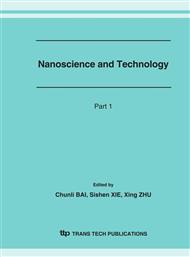p.363
p.369
p.373
p.377
p.381
p.385
p.389
p.395
p.401
Synthesis of Highly Ordered Large-Pore Periodic Mesoporous Organosilica Rods
Abstract:
Highly ordered rods of large-pore periodic mesoporous organosilica (PMO) were successfully synthesized at low acid concentrations and in the presence of inorganic salt using triblock copolymer P123 as template. The roles of inorganic salt, acidity and temperature in the production of highly ordered mesostructure and the morphology control of PMOs were examined and elucidated. It was found that the addition of inorganic salt can dramatically widen the range of the synthesis parameters to produce highly ordered 2D hexagonal pore structure of p6mm symmetry. However, the uniform rods of PMOs can only be synthesized in a narrow range of acid and salt concentrations, which was sensitive to induction time. The results also showed that the optimized salt concentration (1 M) and low acidity (0.167 M) at 40 oC were beneficial to not only the production of highly ordered mesostucture but also the control of rod-like morphology. Highly ordered rods can also be produced at low temperature (35 oC) with high salt amount (1.5 M) or high temperature (45 oC) with low salt concentration (0.5 M).
Info:
Periodical:
Pages:
381-384
Citation:
Online since:
March 2007
Authors:
Price:
Сopyright:
© 2007 Trans Tech Publications Ltd. All Rights Reserved
Share:
Citation:


